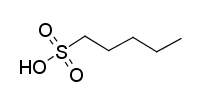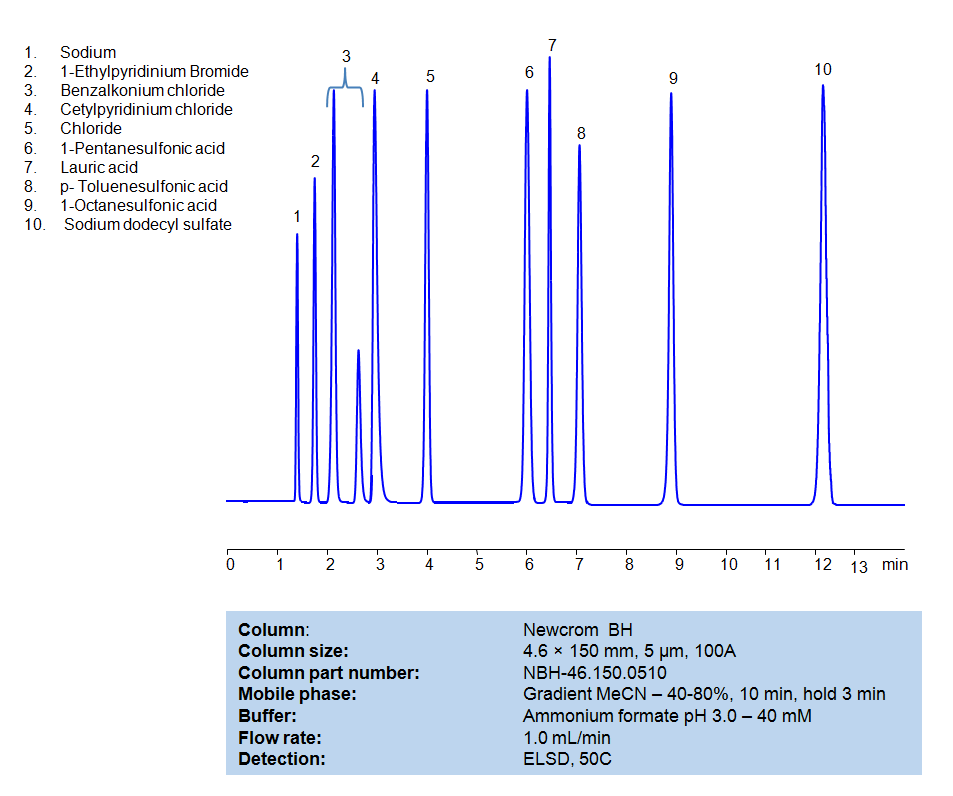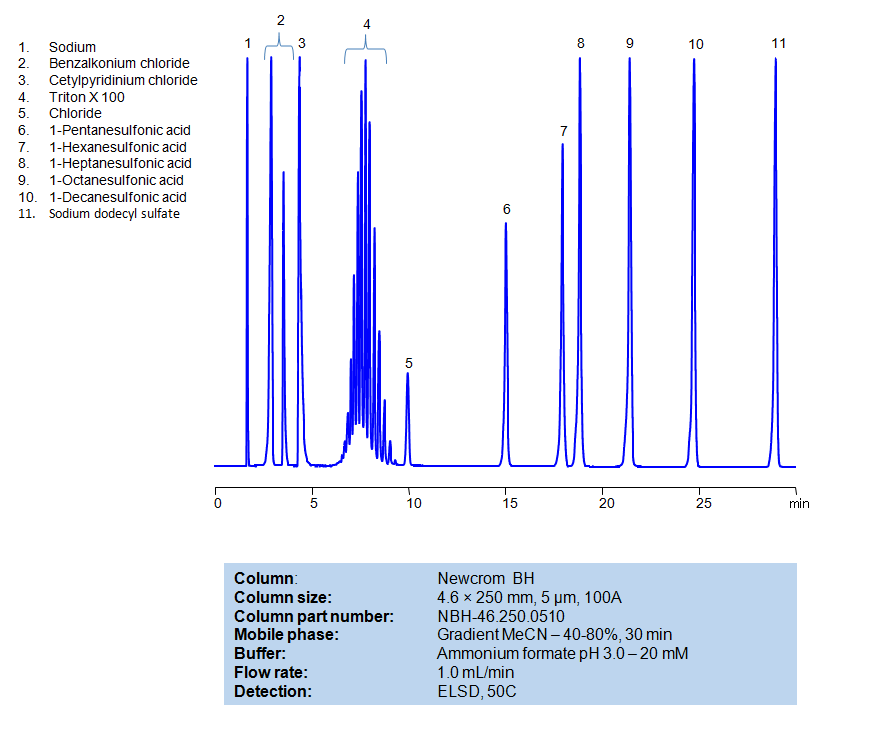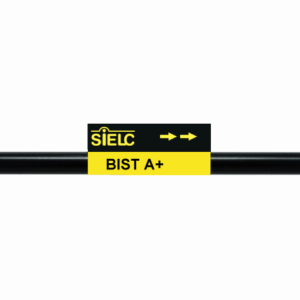| CAS Number | 35452-30-3 |
|---|---|
| Molecular Formula | C5H12O3S |
| Molecular Weight | 152.21 |
| InChI Key | RJQRCOMHVBLQIH-UHFFFAOYSA-N |
| LogP | 0.9 |
| Synonyms |
|
Applications:
HPLC Method for Separation of Hydrophobic, Cationic and Anionic Surfactants on Newcrom BH Column
July 10, 2023
HPLC Method for Separation of Hydrophobic, Cationic and Anionic Surfactants on Newcrom BH by SIELC Technologies
Separation type: Liquid Chromatography Mixed-mode
Surfactants, also known as surface-active agents, are compounds that lower the surface tension (or interfacial tension) between two liquids or between a liquid and a solid. Surfactants may act as detergents, wetting agents, emulsifiers, foaming agents, or dispersants.
They are often classified according to the charge of the polar head group:
Anionic Surfactants: These surfactants have a negative charge on their polar head group. Common examples include soap, sodium laureth sulfate, and sodium lauryl sulfate. They are commonly used in detergents and shampoos due to their ability to emulsify oils and hold dirt in suspension, so it can be rinsed away.
Cationic Surfactants: These surfactants have a positive charge on their polar head group. Examples include cetyltrimethylammonium bromide (CTAB) and benzalkonium chloride. These are often used as antiseptics and can also be found in hair conditioners because they reduce static cling.
Nonionic Surfactants: These surfactants have no charge on their polar head group. Examples include alcohol ethoxylates, nonylphenol ethoxylates, and polysorbates. Nonionic surfactants are often used in laundry and dishwasher detergents.
All compounds can be retained, separated, and analyzed using a reverse-phase Newcrom BH, 4.6 x 150 mm, 5 µm, 100 A, dual ended column. The mobile phase for this method consists of water, acetonitrile (MeCN), and Ammonium formate, which serves as a buffer. This analytical method can be detected with an Evaporative Light Scattering Detector (ELSD) or any other evaporative detection method (CAD, ESI-MS).
High Performance Liquid Chromatography (HPLC) Method for Analysis of Benzalkonium chloride, Cetylpyridinium Chloride, 1-Pentanesulfonic acid, Dodecanoic acid (Lauric acid), p-Toluenesulfonic Acid (PTSA), 1-Octanesulfonic acid, Sodium dodecyl sulfate, 1-Ethylpyridinium bromide
Condition
| Column | Newcrom BH, 4.6 x 150 mm, 5 µm, 100 A, dual ended |
| Mobile Phase | Gradient MeCN -40-80%, 10 min |
| Buffer | Ammonium formate pH 3.0 – 40 mM |
| Flow Rate | 1.0 ml/min |
| Detection | ELSD, 50C |
Description
| Class of Compounds | Surfactants |
| Analyzing Compounds | Benzalkonium chloride, Cetylpyridinium Chloride, 1-Pentanesulfonic acid, Dodecanoic acid (Lauric acid), p-Toluenesulfonic Acid (PTSA), 1-Octanesulfonic acid, Sodium dodecyl sulfate, 1-Ethylpyridinium bromide |
Application Column
Newcrom BH
Column Diameter: 4.6 mm
Column Length: 150 mm
Particle Size: 5 µm
Pore Size: 100 A
Column options: dual ended
1-Octanesulfonic acid
1-Pentanesulfonic acid
Benzalkonium chloride
Cetylpyridinium Chloride
Dodecanoic acid (Lauric acid)
Sodium dodecyl sulfate
p-Toluenesulfonic Acid (PTSA)

HPLC Method for Separation of Hydrophobic, Cationic, Nonionic and Anionic Surfactants on Newcrom BH Column
July 10, 2023
HPLC Method for Separation of Hydrophobic, Cationic, Nonionic and Anionic Surfactants on Newcrom BH by SIELC Technologies
Separation type: Liquid Chromatography Mixed-mode
Surfactants, also known as surface-active agents, are compounds that lower the surface tension (or interfacial tension) between two liquids or between a liquid and a solid. Surfactants may act as detergents, wetting agents, emulsifiers, foaming agents, or dispersants.
They are often classified according to the charge of the polar head group:
Anionic Surfactants: These surfactants have a negative charge on their polar head group. Common examples include soap, sodium laureth sulfate, and sodium lauryl sulfate. They are commonly used in detergents and shampoos due to their ability to emulsify oils and hold dirt in suspension, so it can be rinsed away.
Cationic Surfactants: These surfactants have a positive charge on their polar head group. Examples include cetyltrimethylammonium bromide (CTAB) and benzalkonium chloride. These are often used as antiseptics and can also be found in hair conditioners because they reduce static cling.
Nonionic Surfactants: These surfactants have no charge on their polar head group. Examples include alcohol ethoxylates, nonylphenol ethoxylates, and polysorbates. Nonionic surfactants are often used in laundry and dishwasher detergents.
All compounds can be retained, separated, and analyzed using a reverse-phase Newcrom BH, 4.6 x 250 mm, 5 µm, 100 A, dual ended column. The mobile phase for this method consists of water, acetonitrile (MeCN), and Ammonium formate, which serves as a buffer. This analytical method can be detected with an Evaporative Light Scattering Detector (ELSD) or any other evaporative detection method (CAD, ESI-MS).
High Performance Liquid Chromatography (HPLC) Method for Analysis of Benzalkonium chloride, Cetylpyridinium Chloride, Triton X100, 1-Pentanesulfonic acid, 1-Hexanesulfonic acid, sodium salt, 1-Heptanesulfonic acid, 1-Decanesulfonic acid, Sodium dodecyl sulfate, 1-Octanesulfonic acid
Condition
| Column | Newcrom BH, 4.6 x 250 mm, 5 µm, 100 A, dual ended |
| Mobile Phase | Gradient MeCN -40-80%, 30 min |
| Buffer | Ammonium formate pH 3.0 – 20 mM |
| Flow Rate | 1.0 ml/min |
| Detection | ELSD, 50C |
Description
| Class of Compounds | Aliphatic sulfonic acid |
| Analyzing Compounds | Benzalkonium chloride, Cetylpyridinium Chloride, Triton X100, 1-Pentanesulfonic acid, 1-Hexanesulfonic acid, sodium salt, 1-Heptanesulfonic acid, 1-Decanesulfonic acid, Sodium dodecyl sulfate, 1-Octanesulfonic acid |
Application Column
Newcrom BH
Column Diameter: 4.6 mm
Column Length: 250 mm
Particle Size: 5 µm
Pore Size: 100 A
Column options: dual ended
1-Heptanesulfonic acid
1-Hexanesulfonic acid, sodium salt
1-Octanesulfonic acid
1-Pentanesulfonic acid
Benzalkonium chloride
Cetylpyridinium Chloride
Sodium dodecyl sulfate
Triton X100

HPLC Method for Analysis of 1-Pentanesulfonic acid on Newcrom BH Column
June 27, 2023
HPLC Method for Analysis of 1-Pentanesulfonic acid on Newcrom BH by SIELC Technologies
Separation type: Liquid Chromatography Mixed-mode
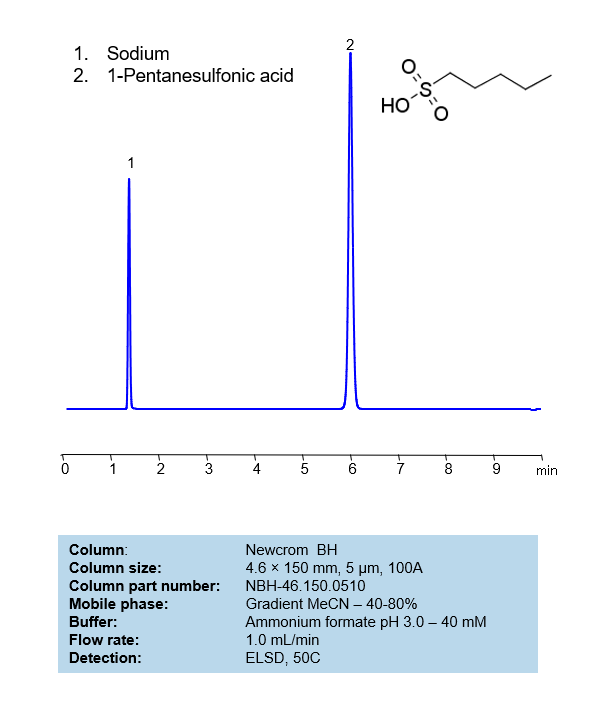
Pentanesulfonic acid, also known as Amyl sulfonic acid or Valeric acid, is an aliphatic sulfonic acid. It has a five-carbon chain (which is where “penta-” comes from) and a sulfonic acid group attached (-SO3H), which is a strong acid group. Its molecular formula is C5H12O3S.
This compound is often used as an ion pairing reagent in reverse-phase chromatography, a type of high performance liquid chromatography (HPLC). As an ion-pairing reagent, it helps retain analytes with ionic (particularly cationic) properties on a reverse phase column by forming a neutral ion pair. This ion pair can then interact with the hydrophobic stationary phase and can be separated based on its hydrophobic properties.
It is also used in the synthesis of a variety of chemical compounds in the laboratory and industrial settings. As with all chemicals, it should be handled with appropriate care, considering its physical and chemical properties, and potential hazards.
The Pentanesulfonic acid can be retained and analyzed using a mixed-mode Newcrom BH, 4.6 x 150 mm, 5 µm, 100 A, dual ended column. The mobile phase for this method consists of water, acetonitrile (MeCN), and Ammonium formate, which serves as a buffer. This analytical method can be detected with an Evaporative Light Scattering Detector (ELSD) or any other evaporative detection method (CAD, ESI-MS).
High Performance Liquid Chromatography (HPLC) Method for Analysis of 1-Pentanesulfonic acid
Condition
| Column | Newcrom BH, 4.6 x 150 mm, 5 µm, 100 A, dual ended |
| Mobile Phase | Gradient MeCN -40-80%, 10 min |
| Buffer | Ammonium formate pH 3.0 – 40 mM |
| Flow Rate | 1.0 ml/min |
| Detection | ELSD, 50C |
Description
| Class of Compounds | Aliphatic sulfonic acid |
| Analyzing Compounds | 1-Pentanesulfonic acid |
Application Column
Newcrom BH
Column Diameter: 4.6 mm
Column Length: 150 mm
Particle Size: 5 µm
Pore Size: 100 A
Column options: dual ended

HPLC Method for Analysis of Sulfonic acids on BIST A+ Column
June 16, 2022
Separation type: Bridge Ion Separation Technology, or BIST™ by SIELC Technologies
HPLC Method for Analysis of Sulfonic acids on BIST A+ Column by SIELC Technologies
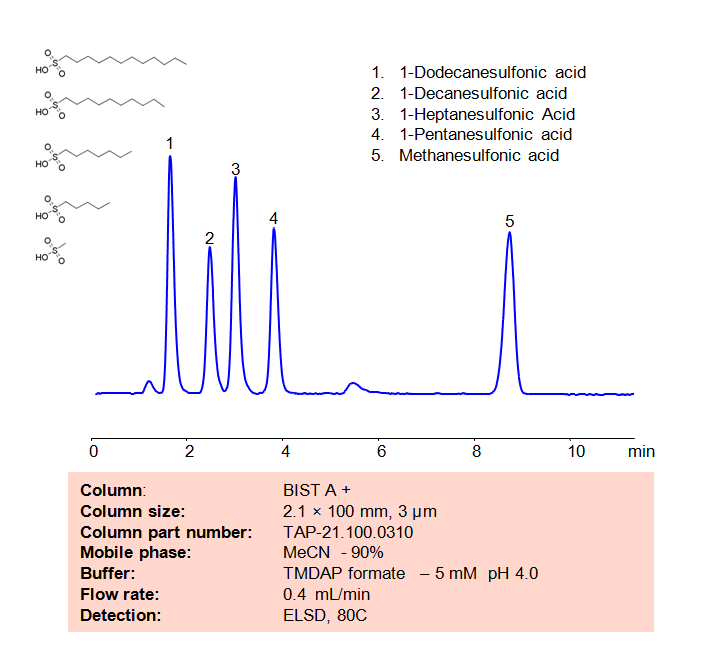
High Performance Liquid Chromatography (HPLC) Method for Analysis of Sulfonic acid
Methanesulfonic acid is a popular non-volatile catalyst used in organic reactions due to it being a strong acid. Other sulfonic acids, like 1-Pentanesulfonic acid, 1-Heptanesulfonic acid, 1-Decanesulfonic acid, and 1=Dodecanesulfonic acid are typically used in ion chromatography and for organic syntheses. Using SIELC’s newly introduced BIST™ method, a mixture of these Sulfonic acids can be separated on a negatively-charged, cation-exchange BIST™ A+ column, contrary to conventional chromatographic wisdom. There are two keys to this retention method: 1) a multi-charged, positive buffer, such as N,N,N’,N’-Tetramethyl-1,3-propanediamine (TMDAP), which acts as a bridge, linking the negatively-charged anion analytes to the negatively-charged column surface and 2) a mobile phase consisting mostly of organic solvent (such as MeCN) to minimize the formation of a solvation layer around the charged analytes. Other positively-charged buffers that can generate BIST™ include Calcium acetate and Magnesium acetate. Using this new and unique analysis method, these Sulfonic acids can be separated, retained, and detected through ELSD. This method is also compatible with Mass Spectrometry (LC-MS) and CAD.
Condition
| Column | BIST™ A+, 2.1×100 mm, 3 µm, 100A |
| Mobile Phase | MeCN – 90% |
| Buffer | TMDAP formate pH 4.0 – 5,0 mM |
| Flow Rate | 0.4 ml/min |
| Detection | ELSD, 80C |
Description
| Class of Compounds | Acid, Sulfonic acid |
| Analyzing Compounds | 1-Dodecanesulfonic acid, 1-Decanesulfonic acid, 1-Heptanesulfonic Acid, 1-Pentanesulfonic acid, Methanesulfonic acid |
Application Column
BIST A+
BIST™ columns offer a unique and effective way to achieve separations that were traditionally challenging or even impossible with other HPLC columns. With the use of a special mobile phase, these ion exchange columns provide very strong retention for analytes with the same charge polarity as the stationary phase, unlocking new chromatography applications. What makes BIST™ columns stand out is their proprietary surface chemistry, which results in superior selectivity, resolution, and sensitivity. These columns offer a simple, efficient solution for a variety of analytical challenges, making them an excellent choice for researchers and analysts across many different fields. To learn more about the technology that powers BIST™ columns and to explore related applications, check out https://BIST.LC.
Select options1-Dodecanesulfonic acid
1-Heptanesulfonic acid
1-Pentanesulfonic acid
Methanesulfonic Acid

